Assessment of arch width changes in Class I and Class II Division 1 patients treated with fixed orthodontics
DOI:
https://doi.org/10.3126/jgmcn.v14i1.37023Keywords:
Inter-molar width, inter-canine width, pre-treatment, post-treatmentAbstract
Background: The orthodontic treatment should aim to maintain the inter-canine and inter-molar width to that of the pre-treatment values. The study was conducted with objective to evaluate arch width changes in Class I and Class II patients treated with fixed orthodontics.
Methods: This was a hospital-based cross-sectional study with two study groups. The first group included patients with Class I malocclusion, treated with four first premolar extractions and the second group included patients with Class II Div 1 malocclusion, treated with upper two first premolar extractions. The inter-canine and inter-molar width of the pre and post-treatment study model were measured. To compare the changes observed amongst two groups, independent samples t-test was performed. A paired sample t-test was used to evaluate the treatment changes within each group.
Results: There was significant increase in inter-canine width in both maxillary and mandibular arches in both the groups. In Class I extraction group there was significant decrease in the inter-molar width in both maxillary and mandibular arches. The Class II Div1 maxillary extraction group also showed significant increase in inter-canine width in both maxillary and mandibular arches. In the same group there was decrease in post treatment
Methods: This was a hospital-based cross-sectional study with two study groups. The first group included patients with Class I malocclusion, treated with four first premolar extractions and the second group included patients with Class II Div 1 malocclusion, treated with upper two first premolar extractions. The inter-canine and inter-molar width of the pre and post-treatment study model were measured. To compare the changes observed amongst two groups, independent samples t-test was performed. A paired sample t-test was used to evaluate the treatment changes within each group.
Results: There was significant increase in inter-canine width in both maxillary and mandibular arches in both the groups. In Class I extraction group there was significant decrease in the inter-molar width in both maxillary and mandibular arches. The Class II Div1 maxillary extraction group also showed significant increase in inter-canine width in both maxillary and mandibular arches. In the same group there was decrease in post-treatment inter-molar width in both arches with significant decrease in the maxillary inter-molar width.
Conclusion: There was increase in inter-canine width in both Class I extraction group and Class II Div 1 maxillary extraction group with decrease in inter-molar width in both the groups.
Downloads
Downloads
Published
How to Cite
Issue
Section
License
This license allows reusers to distribute, remix, adapt, and build upon the material in any medium or format for noncommercial purposes only, and only so long as attribution is given to the creator.




